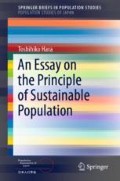Abstract
Based on the historical analysis of Japan’s Demographic Transition (JDT) and using a System Dynamics (SD), approach referencing the World3 (Meadows et al. 1972), I have constructed the Demographic Transition Model of Japan (DTMJ). This model aims to explicate the Demographic Transition (DT) of Japan by logico-mathematical elucidation, with no purpose for exact estimation or projection. Therefore, the use of historical data will be kept at the minimum and the model is designed to reproduce the process of JDT endogenously. According to a causal model of JDT, this model includes six major factors: population-age structure, fertility, reproduction timing, social capital accumulation, lifespan, and migration. In this chapter, the basic concept of modeling, the relations among six major sectors, and the structure and functions of each sector will be analyzed in detail. And the variables and equations of DTMJ will be defined and discussed.
Access this chapter
Tax calculation will be finalised at checkout
Purchases are for personal use only
Notes
- 1.
System Dynamics (SD) was founded by MIT professor Jay Wright Forrester (1918–2016) in the 1950s and his new approach using stocks, flows, internal feedback loops, table functions, and time delays to understand and explain the nonlinear behavior of complex systems over time (Forrester 1968). He had published “Industrial dynamics” (Forrester 1961), “Urban Dynamics” (Forrester 1969), and “World Dynamics” (Forrester 1971). The World Dynamics is a global modeling of the world economy, population, and ecology in the complex interactions at start. It influenced the World3 of “The limits of growth” (Meadows et al. 1972).)
- 2.
It seems unrealistic but the value of default setting can be changed by slider input device during simulation in order to check the effect of female ratio on BirthT.
- 3.
This table belongs to female population, but it is used for the population including males for convenience and simplifying the model structure.
- 4.
The original idea of this equation is based on the fertility equations of World3 written by Donella Meadows. (Meadows et al. 1972: 97).
- 5.
In assumption, the sex ratio at birth is 100 (100 boys to 100 girls) and the female survival rate at aged 50 is 100%, 2 children per women in average mean NRR = 1 and the generation growth rate (r) = 0%. The population will be at a stable state.
- 6.
It contains not only contraceptive use and effectiveness, but broad measures, such as infanticide, induced abortion, prevalence of permanent sterility, artificial reproduction technology. Their effective use depends on social norm, family policy measures, scientific knowledge, etc. They belong to socio-economic and cultural conditions in the category of background determinants.
- 7.
The value of INIT(MT) depends on MT at starting time. For MT = 15 × LE_MLT and LE_MLT = 1 at starting time, the default value is 15 in this model.
- 8.
Per definition, 1ife expectancy is the average time expected to live, calculation based on mortality according to the age-specific death rates at given time. It has an accumulative nature along with individual lifetime in a birth cohort, as well as in periodical development along with the history. It fluctuates radically in the case of natural disaster, an epidemic, starvation, war, and so on. However, these fluctuations are temporal. This model does not include any functions to follow such historical events.
- 9.
These initial values are prepared by historical life table for females (1st Life Table: 1891–1898, Statistics Bureau 2006).
References
Bourgeois-Pichat J (1965) Les facteurs de la fécondité non dirigée. Population 1965/3 20:383–424
Forrester JW (1961) Industrial dynamics. Pegasus Communications, Waltham, MA
Forrester JW (1968) Principles of systems. Productivity Press, Cambridge
Forrester JW (1969) Urban dynamics. Pegasus Communications
Forrester JW (1971) World dynamics. Wright-Allen Press
Meadows DH, Meadows DL, Randers J, Behrens III WW et al (1972) The limits to growth. Potomac Associates—Universe Books. donellameadows.org/wp-content/userfiles/Limits-to-Growth-digital-scan-version.pdf. Accessed 23 Apr 2019
Meadows DL, Behrens III WW, Meadows DH et al (1974) Dynamics of growth in a finite world. Wright Allen Press, New York
Statistics Bureau, Ministry of Internal Affairs and Communications (2006) The historical statistics of Japan, 1 vol. Japan Statistical Association, Tokyo. English edition: Ministry of Internal Affairs and Communications Statistics Bureau (2012) http://www.stat.go.jp/english/data/chouki/index.htm. Accessed 30 Nov 2013
World Bank (2012) World development indicators. http://data.worldbank.org
Author information
Authors and Affiliations
Corresponding author
Rights and permissions
Copyright information
© 2020 The Author(s), under exclusive license to Springer Nature Singapore Pte Ltd.
About this chapter
Cite this chapter
Hara, T. (2020). System Dynamics Model of Demographic Transition. In: An Essay on the Principle of Sustainable Population. SpringerBriefs in Population Studies(). Springer, Singapore. https://doi.org/10.1007/978-981-13-3654-6_4
Download citation
DOI: https://doi.org/10.1007/978-981-13-3654-6_4
Published:
Publisher Name: Springer, Singapore
Print ISBN: 978-981-13-3653-9
Online ISBN: 978-981-13-3654-6
eBook Packages: Social SciencesSocial Sciences (R0)

